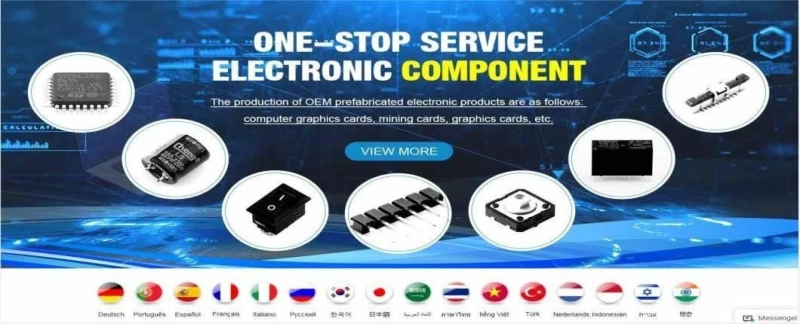Contents
- Introduction Scope
- Exact Model Picks
- System Architecture & Microcontroller Integration
- Power Management & Low-Power Design
- Signal Processing & Peripheral Configuration
- Connectivity: UART, SPI, I2C & More
- Memory Management & Firmware
- Verification: Debug → Simulation → Environmental Testing
- PCB Layout, SI/PI & EMC Compliance
- Toolflow & Development Discipline
- Executive FAQ
This guide targets embedded system engineers and procurement teams selecting and designing with microcontrollers for efficient, reliable, and scalable applications. For a general overview of microcontroller technology, see the Microcontroller article on Wikipedia.
Exact Model Picks
CategoryModelPositioningTypical Fits8-bit MCU (Ultra-Low-Power)ATmega328P20MHz, 32KB flash, 8-bit AVR with UART/SPI/I2C.IoT sensors, consumer electronics, prototyping32-bit MCU (High-Performance)STM32F429ZI180MHz Cortex-M4F, 2MB flash, TFT-LCD controller.HMI, industrial automation, medical devices32-bit MCU (Automotive)NXP SPC5744P160MHz PowerPC, 2.5MB flash, AEC-Q100, CAN-FD.Automotive ECUs, motor control, ADAS16-bit MCU (Low-Cost)MSP430FR413316MHz, 15KB FRAM, ultra-low-power with LCD driver.Battery-powered meters, wearable devicesVoltage Regulator (LDO)TPS7A05200mA, 1µA quiescent, 1-5.5V ultra-low-power LDO.Battery-powered MCU systems, IoT nodesESD Protection (IO Pins)PESD5V0U1BA±15kV ESD protection, low-capacitance for GPIO.Exposed MCU interfaces, USB/UART portsCrystal OscillatorABM8G-25.000MHZ25MHz, ±10ppm, low-power crystal for MCU clocks.Precision timing, industrial controllers
Note: Select microcontrollers with industrial or AEC-Q100 ratings for reliability. Verify toolchain support and supply chain longevity before design-in.
System Architecture & Microcontroller Integration
Microcontroller designs require balanced performance, power, and peripheral selection: define clock speeds (1-200MHz), memory (8KB-4MB), and interfaces (UART, SPI, I2C, CAN). Version firmware configurations and peripheral mappings in CI, ensuring no regressions in interrupt latency or power draw. Architect for modularity with reusable drivers.
// Example UART init (C, STM32 HAL for STM32F429ZI)
void uart_init(void) {
huart2.Instance = USART2;
huart2.Init.BaudRate = 115200;
huart2.Init.WordLength = UART_WORDLENGTH_8B;
huart2.Init.StopBits = UART_STOPBITS_1;
huart2.Init.Parity = UART_PARITY_NONE;
HAL_UART_Init(&huart2);
}
Partitioning Heuristics
- Processing Use 8-bit MCUs (ATmega328P) for cost-sensitive tasks; 32-bit (STM32F429ZI, SPC5744P) for high-performance.
- Power Deploy LDOs (TPS7A05) for low-power; crystals (ABM8G-25.000MHZ) for stable clocks.
- Protection Add ESD protection (PESD5V0U1BA) for exposed GPIO or serial pins.
Microcontrollers (MCUs) are the core of embedded systems, integrating CPU, memory, and peripherals for tasks like IoT, automotive control, and industrial automation. They range from 8-bit low-power units to 32-bit high-performance cores with DSP and FPU. Applications demand specific peripherals: UART for serial, SPI/I2C for sensors, and CAN for automotive networks.
Architecturally, MCU systems split into processing (CPU core), peripherals (timers, ADC, UART), and power management. Firmware abstracts peripherals via HAL or RTOS, enabling scalability. Interrupt latency (<10µs) and power modes (sleep, deep-sleep) are critical for real-time and battery-powered designs. For automotive, AEC-Q100 MCUs like SPC5744P ensure ISO 26262 compliance.
Scalability requires modular firmware: use CMSIS for ARM-based MCUs or vendor HALs for portability. In networked systems, integrate with CAN or Ethernet for diagnostics, logging to flash for traceability.
Power Management & Low-Power Design
Function
Supply 1.8-5V rails for MCU cores and peripherals; optimize for <1µA sleep current in battery-powered designs. Protect against transients and EMI.
Package & Electrical
ATmega328P: 32-pin TQFP; decouple Vcc at 0.1µF + 10µF. STM32F429ZI: 144-pin LQFP; use thermal vias; bypass Vdda at 4.7µF. TPS7A05: SOT-23; place near MCU power pins.
Performance & Calibration
Measure sleep current <1µA; validate ripple <20mVpp. Archive power profiles for CI; calibrate brown-out thresholds for <1% error.
Applications
- IoT edge nodes, wearable devices, automotive ECUs.
- Industrial sensors, battery-powered HMI.
Power management ensures MCU efficiency. LDOs like TPS7A05 deliver ultra-low quiescent current for battery systems, while bucks support high-current cores. Power modes (active, sleep, deep-sleep) optimize consumption, with wake-up times <10µs. Protection includes ESD diodes (PESD5V0U1BA) for GPIO and transient clamping for automotive (ISO 7637-2).
Ground planes split digital and analog domains, stitched with 0Ω shunts. Sequencing uses supervisors (e.g., TPS3899) to ensure stable Vcc before boot (<50ms). Calibration trims oscillator drift and power thresholds, logged to EEPROM.
Signal Processing & Peripheral Configuration
Function
Configure MCU peripherals (ADC, PWM, UART) for signal processing; optimize interrupt latency (<10µs) and ADC accuracy (12-16 bits). Log diagnostic data.
Package & Electrical
MSP430FR4133: 64-pin VQFN; route ADC inputs with 0.01µF decoupling. SPC5744P: 144-pin LQFP; shield PWM traces with ground vias. PESD5V0U1BA: place near exposed IO pins.
Performance & Calibration
Measure ADC ENOB >12 bits; validate PWM jitter <100ns. Log peripheral configs for traceability.
Applications
- Sensor data acquisition, motor control PWM, serial communication.
- Automotive diagnostics, industrial process control.
Signal processing leverages MCU peripherals: ADCs for sensor data, PWM for motor control, and UART/SPI for communication. Calibration adjusts ADC references (±1%) and PWM frequencies, stored in flash. Diagnostics monitor interrupt overruns, logged to non-volatile memory.
In high-noise environments, filter ADC inputs with RC networks (100Ω/10nF). For real-time systems, prioritize interrupts (NVIC for ARM) to ensure <5µs response. Formal verification proves peripheral timing, avoiding deadlocks.
Connectivity: UART, SPI, I2C & More
Function
Enable MCU connectivity via UART, SPI, I2C, or CAN; ensure protocol latency <1ms. Protect interfaces against ESD and EMI.
Package & Electrical
STM32F429ZI: route SPI/I2C with 4.7kΩ pull-ups; decouple Vcc at 0.1µF. ATmega328P: UART TX/RX with 100Ω series resistors. PESD5V0U1BA: inline on exposed pins.
Performance & Calibration
Validate BER <10^-9 for UART at 1Mbps; test I2C clock stretching <100µs. Log protocol errors for CI.
Applications
- IoT gateways, automotive CAN networks, sensor hubs.
- Industrial HMI, diagnostic interfaces.
MCU connectivity supports multiple protocols: UART for serial, SPI/I2C for sensors, and CAN for automotive. Hardware flow control (RTS/CTS) prevents UART overruns, while SPI/I2C uses DMA for efficiency. Calibration tunes baud rates and clock speeds, ensuring ±2% accuracy.
Protection includes ESD diodes for exposed pins and EMI filters (e.g., ferrite beads, 600Ω at 100MHz). In networked systems, integrate with Ethernet or LoRa for cloud connectivity, buffering data in SRAM.
Memory Management & Firmware
Function
Manage MCU flash (8KB-4MB) and SRAM; store configurations and logs in EEPROM. Support OTA firmware updates via UART/SPI.
Package & Electrical
Use I2C EEPROM (e.g., 24LC256); route SDA/SCL with 4.7kΩ pull-ups; add 100Ω series resistors. Decouple MCU Vcc at 0.1µF-10µF.
Performance & Calibration
Verify 1M write cycles at 85°C; retention >10yrs. Log firmware versions for audit.
Applications
- Dynamic peripheral configuration, secure OTA updates.
- Diagnostic logging for automotive and industrial systems.
Memory management optimizes MCU flash and SRAM usage. EEPROMs store configurations (e.g., UART baud rates), updated via I2C. OTA bootloaders enable field updates, with CRC32 for integrity. Secure storage uses AES-128 for tamper-proof logs, per ISO 21434.
Verification: Debug → Simulation → Environmental Testing
Verification spans debug (JTAG/SWD), simulation (Keil/IAR), and environmental tests (IEC 60068). CI gates: lint → sim → HIL → thermal/vibration. Log interrupt latency and power metrics.
// UART loopback test (Python, pyserial)
import serial
ser = serial.Serial('COM1', 115200, timeout=1)
ser.write(b'TEST')
assert ser.read(4) == b'TEST'
ser.close()
Verification ensures MCU reliability. JTAG/SWD debugs firmware, while simulators test peripheral behavior. HIL rigs emulate sensor or network inputs, logging response times. Environmental tests validate -40°C to 85°C, 10G vibration, and 95% humidity.
Formal methods prove interrupt prioritization, avoiding deadlocks. EMC tests (CISPR 25) confirm <30dBµV/m emissions. Production tests use bed-of-nails for pin continuity, targeting >99.5% yield.
PCB Layout, SI/PI & EMC Compliance
- Route MCU clocks and IO at 50Ω; shield with ground pours.
- PI: Decouple Vcc at 0.1µF-10µF; target <50mΩ impedance at 1MHz.
- EMC: Place ESD protection <5mm from IO pins; add ferrites for 10MHz.
- Use 4-layer PCBs for high-speed; 2-layer for simple designs.
PCB layout prioritizes MCU signal integrity: short clock traces, <5mm from crystal (ABM8G-25.000MHZ). PI analysis ensures <20mV ripple, using Sigrity. EMI mitigation includes ferrite beads and via fences. Fabrication specs mandate IPC-A-600 Class 2, with ENIG finish.
Toolflow & Development Discipline
- Version KiCad/Altium schematics; automate BOM-netlist diffs.
- Diagnostics: JTAG debuggers, logic analyzers for peripheral signals.
- Artifacts: Gerbers, firmware binaries, test vectors, EMC certs.
Toolflows streamline MCU design: STM32Cube for STM32, MPLAB X for Microchip. Diagnostics include SWD for real-time tracing and oscilloscopes for signal decode. CI/CD pipelines gate releases on passing HIL and EMI tests.
Executive FAQ
Q: Why choose microcontrollers over FPGAs for embedded systems?
A: MCUs offer lower cost, integrated peripherals, and faster development for most applications.
Q: How do microcontrollers ensure reliability in automotive designs?
A: AEC-Q100 ratings, robust power management, and diagnostics meet ISO 26262 standards.
For efficient microcontroller designs in IoT, automotive, and industrial applications, align with Chipmlc integrated circuit, ensuring performance, reliability, and supply chain continuity.



